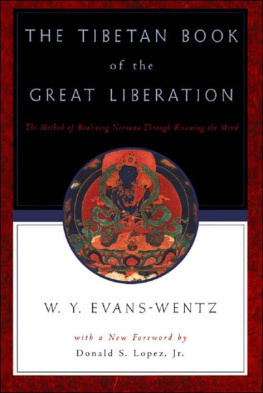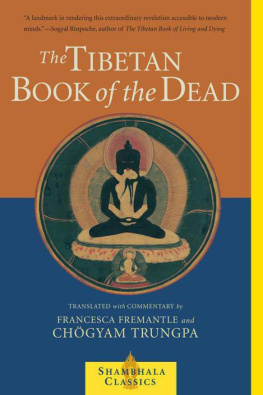THE TIBETAN BOOK OF THE DEAD

(reading left to right)
THE TRANSLATOR AND THE EDITOR IN GANGTOK, SIKKIM
Described on page xxvii

FOLIOS 35A AND 67a OF THE BARDO THODOL MS.
Described on page xxvii
THE TIBETAN BOOK OF THE DEAD
OR
The AfterDeath Experiences
on the Bardo Plane, according
to LMa Kazi DawaSamdups
English Rendering
Compiled and edited by
W. Y. Evans-Wentz
with a new
Foreword and Afterword by
Donald S. Lopez, Jr.


Oxford New York
Athens Auckland Bangkok Bogot Buenos Aires Calcutta
Cape Town Chennai Dar es Salaam Delhi Florence Hong Kong
Istanbul Karachi Kuala Lumpur Madrid Melbourne Mexico City Mumbai
Nairobi Paris So Paulo Singapore Taipei Tokyo Toronto Warsaw
and associated companies in
Berlin Ibadan
Copyright 1960, 2000 by W. Y. EvansWentz
First published by Oxford University Press, London, 1927
Second Edition, 1949
Third Edition, 1957
First issued as an Oxford University Press paperback, 1960
New Foreword and Afterword copyright 2000 by
Donald S. Lopez, Jr.
Published by Oxford University Press, Inc.,
198 Madison Avenue, New York, New York 10016
Oxford is a registered trademark of Oxford University Press
All rights reserved. No part of this publication may be reproduced,
stored in a retrieval system, or transmitted, in any form or by any means,
electronic, mechanical, photocopying, recording, or otherwise,
without the prior permission of Oxford University Press.
Library of Congress CataloginginPublication Data
Karmaglinpa, 14th cent.
[Bar do thos grol. English]
The Tibetan book of the dead; or, The afterdeath experiences on the Bardo plane, according to LMa Kazi DawaSamdups English rendering / compiled and edited by W.Y. EvansWentz; with a new foreword and afterword by Donald S. Lopez, Jr.
p. cm.
Includes Index.
ISBN 0195133110 ISBN 0195133129 (pbk.)
1. Intermediate stateBuddhismEarly works to 1800. 2. DeathReligious aspectsBuddhismEarly works to 1800. 3. Funeral rites and ceremonies, BuddhistChinaTibetEarly works to 1800. I. Title.
BQ4490.K3713 2000
294.3423dc21
00022529
13 5 7 9 8 6 4 2
Printed in the United States of America
on acid free paper
IN MEMORY OF
MY DECEASED FATHER AND MOTHER
I DEDICATE
THIS BOOK TO MY TEACHERS
BOTH SECULAR AND RELIGIOUS
IN EUROPE AND AMERICA
AND THROUGHOUT
THE ORIENT
Thou shalt understand that it is a science most profitable, and passing all other sciences, for to learn to die. For a man to know that he shall die, that is common to all men ; as much as there is no man that may ever live or he hath hope or trust thereof; but thou shalt find full few that have this cunning to learn to die.... I shall give tliec the mystery of this doctrine; the which shall profit thec greatly to the beginning of ghostly health, and to a stable fundament of all virtues. Orologium Sapnenliae.
Against his will he dieth that hath not learned to die. Learn to die and thou shalt learn to live, for there shall none learn to live that hath not learned to die. Toure of all Toures: and Teacheth a Man for to Die.
The Book of the Craft of Dying (Compcrs Edition).
Whatever is here, that is there ; what is there, the same is here. He who seeth here as different, mectcth death after death.
By mind alone this is to be realized, and [then] there is no difference here. From death to death he goeth, who seeth as if there is difference here. Katha Upunish ad, iv. ion (Swami Sharvananda7 Translation).
FOREWORD
Donald S. Lopez, Jr.
A certain trepidation attends the decision to accept an invitation to write a foreword to new editions, published in 2000, of the four books of W. Y. EvansWentz: The Tibetan Book of the Dead, Tibets Great Yogi Milarepa, Tibetan Yoga and Secret Doctrines,and The Tibetan Book of the Great Liberation.The four books in their old editions are already burdened with numerous prefaces, commentaries, and introductions, causing one to wonder what another preface could possibly add. It seems inevitable that the four books of EvansWentz will continue to outlive yet another generation of commentators, such that anything that a scholar might add today will only serve as material for a scholar some fifty years from now, who will demonstrate the biases and misunderstandings of a preface written fifty years ago, a preface that merely offers evidence of the fin de sicle Zeitgeist of those who once called themselves postmoderns.
The four books of EvansWentz are surely groundbreaking works, the first to bring translations of Tibetan Buddhist texts to the Englishspeaking public. EvansWentz was equally avant garde in his method, collaborating closely with Tibetan scholars, a practice that would not become common for another four decades, after the Tibetan diaspora began in 1959. Yet, for the scholar of the present day, looking back now more than seventy years to the publication of the first volume of the series, The Tibetan Book of the Dead,in 1927, the Tibetan tetralogy of W. Y. EvansWentz, although a product of our century, seems to have originated in another age. All four books assume the undifferentiated dichotomy of the materialist West and the mystic East, an East that holds the secret to the Wests redemption. Few of the concerns of scholarssuch as language or culture or historyare to be found in the books. Instead, the volumes are presented as repositories of a timeless wisdom preserved by the East, a wisdom that will someday save the West, ultimately overcoming the duality of the hemispheres to culminate in the Unity of Mankind. This apparently beatific vision has since been shown to be the product of a romantic Orientalism that viewed the traditions of Asia as a natural resource to be extracted and refined for the consumption of the West; the books thus mark a moment in the history of colonialism.
Yet the four books of EvansWentz, especially the first, represent an important moment in that history. The products of a chance encounter between a Sikkimese school teacher and an American eccentric traveling in British India in 1919, the books have proved to be among the most durable products of the centurys romance of Tibet, radiating their influence far beyond what might be expected from such an unlikely beginning.
Walter Wentz was born in Trenton, New Jersey, in 1878, the son of a German immigrant and an American Quaker. The late nineteenth century was a period of great fascination with spiritualism, the belief that spirits of the dead could be contacted through seances, materialization, automatic writing, and other techniques. Walter took an early interest in the books on spiritualism in his fathers library, reading as a teen both his Unveiledand The Secret Doctrineby Madame Blavatsky of the Theosophical Society. These works were to have a profound effect on Walter Wentz. Indeed, it is impossible to appreciate his tetralogy without recognizing his lifelong commitment to Theosophy.
Next page















